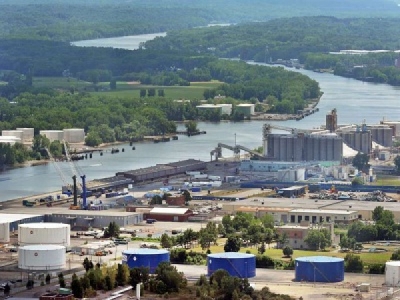
Posted on October 5, 2017
By Brian Nearing, TimesUnion.com
The first step toward a $41 million project to dredge PCBs and other toxins from the Hudson River near a former Rensselaer dye factory is expected to start this fall.
BASF Corp. will begin by installing more than 500 feet of new steel bulkhead to toughen a seawall along the Hudson on Riverside Avenue, according to the state Department of Environmental Conservation.
The seawall must be stabilized before the company can begin the river dredging, which is scheduled to start next year, according to DEC. BASF will be performing and paying for the cleanup under the state Superfund program.
PCBs found in that part of the river did not come from BASF, which did not use the chemical during its production, but the other hazardous compounds did. “PCBs were also found in upstream sediment samples at comparable levels” to the area that BASF studied, according to DEC.
DEC wants dredging in the river to remove PCBs, volatile organics, and toxic heavy metals like lead, cadmium, copper, mercury, zinc and arsenic, that got into the river from several production sewer and storm water discharge pipes. The former factory was knocked down in 2010.
PCB levels in that part of the river reached up to 270 parts per million. The safety standard is 1 ppm.
The dye factory closed in 2000, and that year, BASF signed an agreement with DEC to clean up the 75-acre plant and a 35-acre site to the south.
The DEC plan calls for dredging about 38,700 cubic yards from about 12 acres of tainted river bottom that extend along about 1,800 feet of riverfront at the Port of Rensselaer.
That is equivalent to about a dozen Olympic-sized swimming pools. Dredging in the river would be done to a maximum depth of about eight feet.
About 7,000 cubic yards of the least-polluted dredgings could be processed at the site through a process called thermal desorption.
That would work by heating contaminated soils to 800 degrees Fahrenheit to evaporate chemicals into gas. The gas is then run through a second treatment which runs at a higher temperature to destroy dangerous components in the gas.
The rest of the dredgings, which would contain higher levels of PCBs and other pollution, would be removed for disposal at a hazardous waste landfill.
BASF tests of the site found no evidence that pollution was migrating through soil or groundwater to surrounding properties.
Source: timesunion





